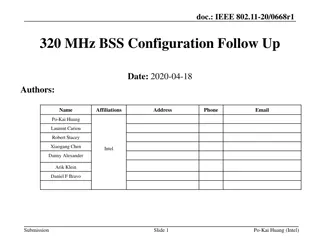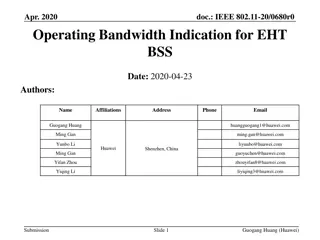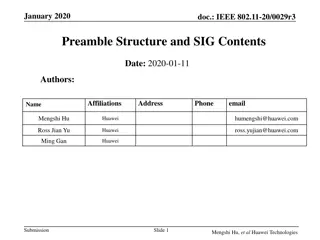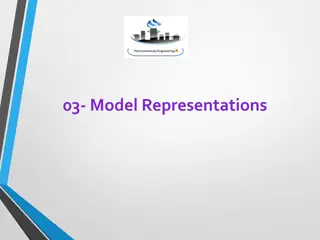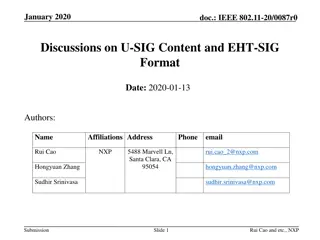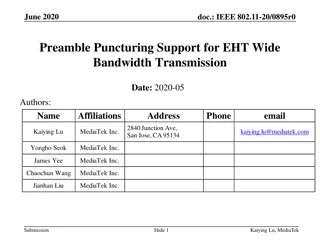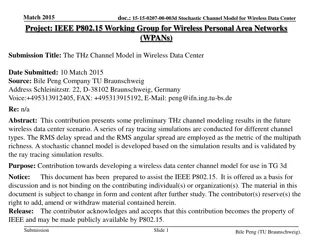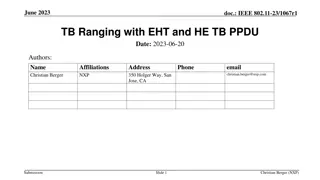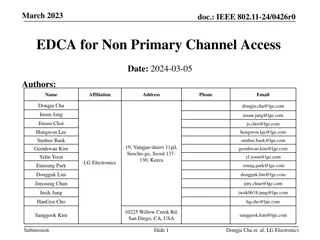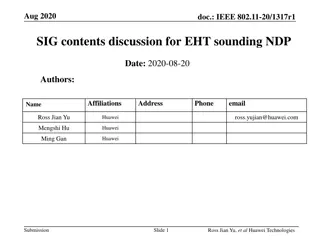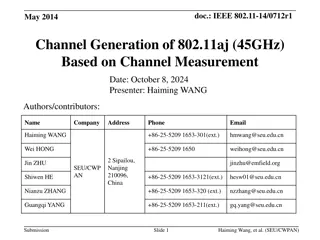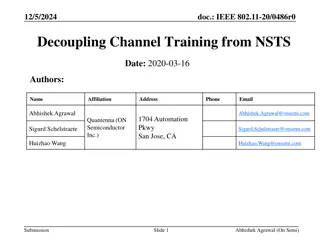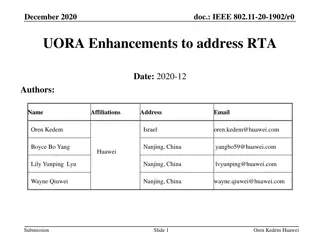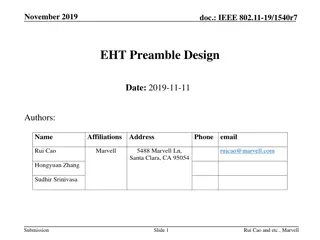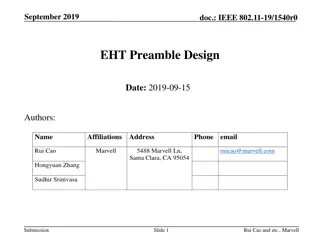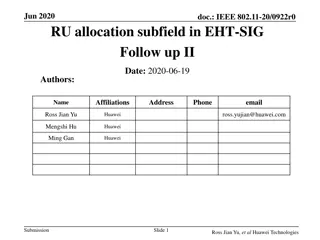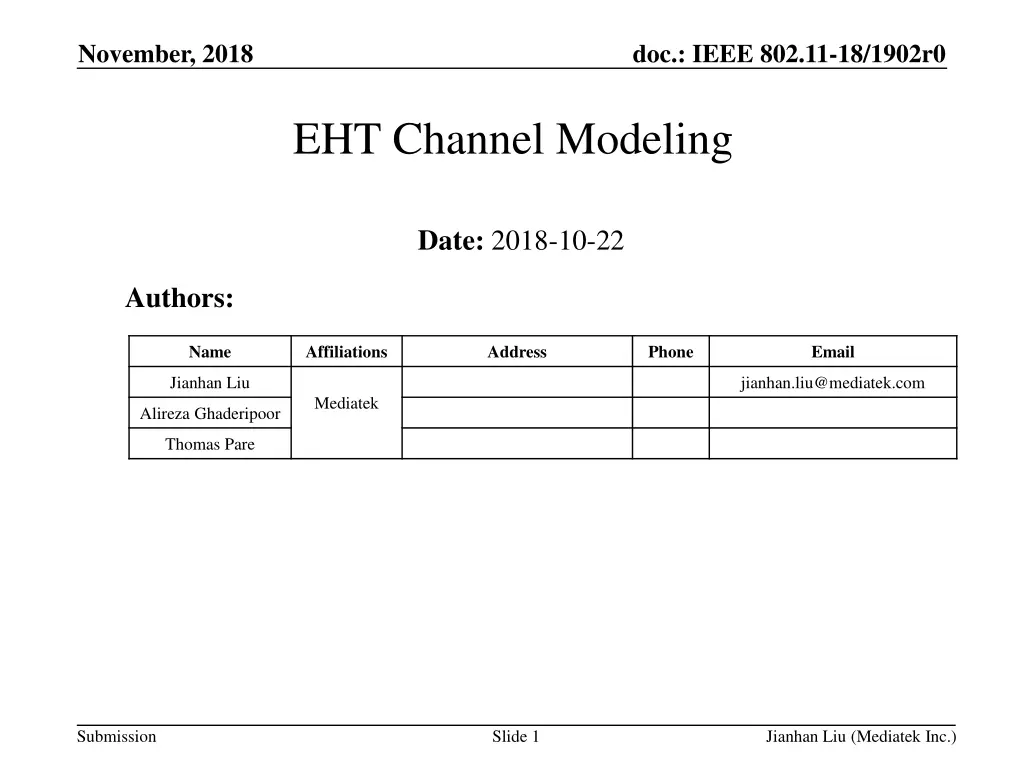
IEEE 802.11 EHT Channel Modeling Update 2018
Explore the latest advancements in channel modeling for IEEE 802.11 EHT technology, including multi-AP coordination, 320MHz bandwidth, and 16 spatial streams. Learn about the proposed channel models for the 6GHz band, spatial stream correlations, and more to enhance system simulations for EHT deployment.
Download Presentation

Please find below an Image/Link to download the presentation.
The content on the website is provided AS IS for your information and personal use only. It may not be sold, licensed, or shared on other websites without obtaining consent from the author. If you encounter any issues during the download, it is possible that the publisher has removed the file from their server.
You are allowed to download the files provided on this website for personal or commercial use, subject to the condition that they are used lawfully. All files are the property of their respective owners.
The content on the website is provided AS IS for your information and personal use only. It may not be sold, licensed, or shared on other websites without obtaining consent from the author.
E N D
Presentation Transcript
November, 2018 doc.: IEEE 802.11-18/1902r0 EHT Channel Modeling Date: 2018-10-22 Authors: Name Affiliations Address Phone Email Jianhan Liu jianhan.liu@mediatek.com Mediatek Alireza Ghaderipoor Thomas Pare Submission Slide 1 Jianhan Liu (Mediatek Inc.)
November, 2018 doc.: IEEE 802.11-18/1902r0 Introduction Some well accepted features for EHT are listed as follows Multi-AP Coordination 320MHz bandwidth (including operations in 6GHz band) 16 Spatial Streams Technical proposal selection requires a more precise channel model for link level simulations and PHY abstractions for system level simulation in EHT. Channel models for 6GHz band and 320MHz BW need to be added for EHT. To enable 16 spatial streams, the correlations among the antennas must be taken into account due to the foot size of an AP and large number of antennas; Submission Slide 2 Jianhan Liu (Mediatek Inc.)
November, 2018 doc.: IEEE 802.11-18/1902r0 Channel models for 6GHz band and 320MHz BW Given that 6GHz band is close to 5GHz band, we suggest that the channel models for 6GHz band use the same model as in 5GHz band. Generation of 320MHz Channel: Using the channel generation method described in [1]: Table 1: Channel sampling rate expansion (tap spacing reduction) factors System Bandwidth W Channel Sampling Rate Expansion Factor 1 2 4 8 16 PDP Tap Spacing 10 ns 5 ns 2.5 ns 1.25 ns 0.625ns W 40 MHz 40 MHz < W 80 MHz 80 MHz < W 160 MHz 160 MHz < W 320 MHz 320 MHz < W 640 MHz TGn Tap i TGn Tap (i+1) 10ns/k = 2.5ns 10ns/k = 2.5ns 10ns/k = 2.5ns 20ns Figure 1: Illustration of PDP tap interpolation scheme for channel bandwidth expansion Slide 3 Submission Jianhan Liu (Mediatek Inc.)
November, 2018 doc.: IEEE 802.11-18/1902r0 Correlations in Multiple Antennas Systems In 11n/ac/ax, we model the correlations at AP with a correlation matrix ??? with antenna distance ? and we model the correlations at the non- AP STA with a correlation matrix ???? ?? with antenna distance ? Given that EHT is likely to introduce more antennas at the AP and the foot-size of EHT AP may be different, we suggest to add the following correlation parameters to EHT. Three correlation matrices at the AP. Low correlations: ??? with antenna distance ? Medium correlations: ??? with antenna distance ?/2 High correlations: ??? with antenna distance ?/4 The correlation parameter at the Non-AP STA keeps antenna distance ? 2. 2 In 11n/ac/ax, each channel tap has a different correlation matrix realization, EHT should follow the same method. Submission Slide 4
November, 2018 doc.: IEEE 802.11-18/1902r0 Channel Models for Multiple AP Systems AP 2 AP 1 H(1,1) H(2,2) H(2,1) H(1,2) STA1 STA2 Base on the assumption is the antenna distances between two APs and two non-AP STAs are large, we have ?(1,1) = ????1?1,1???1 ?(2,1) = ????1?2,1???2 ?(1,2) = ????2?1,2???1 ?(2,2) = ????2?2,2???2 ??,? is the channel between AP #m and non-AP STA #n with infinity antenna distance. Submission Slide 5 Jianhan Liu (Mediatek Inc.)
November, 2018 doc.: IEEE 802.11-18/1902r0 On Outdoor Channel Modelling and Doppler In 11ax, UMi channel models have been adopted as the outdoor channel models with Doppler modifications [2]. However, some of the scenarios for UMi channel models are not applicable to WLAN. For example, delay spread of UMi channels can be up to 16us. In 11n/ac channel generator for channels A,B,C,D and F, the Doppler generation is different from UMi channel model. Two suggestions: 1. Limit the delay spread to TBD (<16us) us for UMi channel model Make the scenarios more suitable for WLAN 2. Unify the Doppler generation for other channel types using method in UMi model. It can be shown that UMi model can generate the same Doppler spectrum as measured in 11n channel model document [3]. The 11n/ac channel generator just generator Doppler based on average sense. Submission Slide 6 Jianhan Liu (Mediatek Inc.)
November, 2018 doc.: IEEE 802.11-18/1902r0 References [1] TGac Channel Model Addendum , IEEE 802.11-09/0308r12, Greg Breit, etc. [2] Tgax channel model document , IEEE 802.11-14/0882r4, Jianhan Liu, etc. [3] TGn Channel Models , IEEE 802.11-03/0940r4, Vinko Erceg, etc. Submission Slide 7 Jianhan Liu (Mediatek Inc.)



